Degradation of Tetracycline Hydrochloride by a Novel CDs/g-C3N4/BiPO4 under Visible-Light Irradiation: Reactivity and Mechanism
Abstract
:1. Introduction
2. Results and Discussion
2.1. Characterization of CDBPC
2.2. Effect of Preparation Conditions on CDBPC Catalytic Performance
2.3. Effects of Operating Parameters on the Degradation of TC
2.4. Degradation Kinetics of TC
2.5. Free Radical Identification
2.6. Proposed Reaction Mechanism
3. Materials and Methods
3.1. Materials and Chemicals
3.2. Preparation of CDs/g-C3N4/BiPO4
3.3. Photocatalytic Activity of the CDBPC Composite by Beaker Experiments
3.4. Analytical Methods
3.5. Reaction Kinetics
4. Conclusions
Author Contributions
Funding
Data Availability Statement
Conflicts of Interest
References
- Zhang, Q.Q.; Ying, G.G.; Pan, C.G.; Liu, Y.S.; Zhao, J.L. Comprehensive evaluation of antibiotics emission and fate in the river basins of China: Source analysis, multimedia modeling, and linkage to bacterial resistance. Environ. Sci. Technol. 2015, 49, 6772. [Google Scholar] [CrossRef] [PubMed]
- Lu, P.; Fang, Y.; Barvor, J.B.; Neth, N.L.K.; Fan, N.; Li, Z.; Cheng, J. Review of Antibiotic Pollution in the Seven Watersheds in China. Pol. J. Environ. Stud. 2019, 28, 4045–4055. [Google Scholar] [CrossRef]
- Jia, L.; Lya, C.; Lan, Z.B.; By, B.; Li, W. Antibiotics in soil and water in China—A systematic review and source analysis. Environ. Pollut. 2020, 266, 115147. [Google Scholar]
- Kumar, M.; Jaiswal, S.; Sodhi, K.K.; Shree, P.; Singh, D.K.; Agrawal, P.K.; Shukla, P. Antibiotics bioremediation: Perspectives on its ecotoxicity and resistance. Environ. Int. 2019, 124, 448–461. [Google Scholar] [CrossRef] [PubMed]
- Hain, E.; Adejumo, H.; Anger, B.; Orenstein, J.; Blaney, L. Advances in antimicrobial activity analysis of fluoroquinolone, macrolide, sulfonamide, and tetracycline antibiotics for environmental applications through improved bacteria selection. J. Hazard. Mater. 2021, 415, 125686. [Google Scholar] [CrossRef] [PubMed]
- Danner, M.C.; Robertson, A.; Behrends, V.; Reiss, J. Antibiotic pollution in surface fresh waters: Occurrence and effects. Sci. Total Environ. 2019, 664, 793–804. [Google Scholar] [CrossRef]
- Tang, J.; Fang, J.; Tam, N.F.; Yang, Y.; Dai, Y.; Zhang, J.; Shi, Y. Impact of Phytoplankton Blooms on Concentrations of Antibiotics in Sediment and Snails in a Subtropical River, China. Environ. Sci. Technol. 2021, 55, 1811–1821. [Google Scholar] [CrossRef]
- Chao, Y.; Zhang, J.; Li, H.; Wu, P.; Li, X.; Chang, H.; Zhu, W. Synthesis of boron nitride nanosheets with N-defects for efficient tetracycline antibiotics adsorptive removal. Chem. Eng. J. 2020, 387, 124138. [Google Scholar] [CrossRef]
- Zhou, Y.; Gao, Y.; Jiang, J.; Shen, Y.M.; Pang, S.Y.; Wang, Z.; Duan, J.; Guo, Q.; Guan, C.; Ma, J. Transformation of tetracycline antibiotics during water treatment with unactivated peroxymonosulfate. Chem. Eng. J. 2020, 379, 122378. [Google Scholar] [CrossRef]
- Liu, L.; Xu, Q.; Owens, G.; Chen, Z. Fenton-oxidation of rifampicin via a green synthesized rGO@nFe/Pd nanocomposite. J. Hazard. Mater. 2020, 402, 123544. [Google Scholar] [CrossRef]
- Jeong, W.G.; Kim, J.G.; Baek, K. Removal of 1,2-dichloroethane in groundwater using Fenton oxidation. J. Hazard. Mater. 2022, 428, 128253. [Google Scholar] [CrossRef]
- Mizuno, Y.; Yahaya, A.G.; Kristof, J.; Blajan, M.G.; Murakami, E.; Shimizu, K. Ozone Catalytic Oxidation for Gaseous Dimethyl Sulfide Removal by Using Vacuum-Ultra-Violet Lamp and Impregnated Activated Carbon. Energies 2022, 15, 3314. [Google Scholar] [CrossRef]
- Fu, C.; Yi, X.; Liu, Y.; Zhou, H. Cu2+ activated persulfate for sulfamethazine degradation. Chemosphere 2020, 257, 127294. [Google Scholar] [CrossRef] [PubMed]
- Fagan, W.P.; Zhao, J.; Villamena, F.A.; Zweier, J.L.; Weavers, L.K. Synergistic, aqueous PAH degradation by ultrasonically activated persulfate depends on bulk temperature and physicochemical parameters-ScienceDirect. Ultrason. Sonochem. 2020, 67, 105172. [Google Scholar] [CrossRef] [PubMed]
- Huang, S.; Wang, G.; Liu, J.; Du, C.; Su, Y. A novel CuBi2O4/BiOBr direct Z-scheme photocatalyst for efficient antibiotics removal: Synergy of adsorption and photocatalysis on degradation kinetics and mechanism insight. ChemCatChem 2020, 12, 4431–4445. [Google Scholar] [CrossRef]
- Das, S.; Ahn, Y.H. Synthesis and application of CdS nanorods for LED-based photocatalytic degradation of tetracycline antibiotic. Chemosphere 2022, 291, 132870. [Google Scholar] [CrossRef]
- Gholami, P.; Khataee, A.; Bhatnagar, A.; Vahid, B. Synthesis of N-Doped Magnetic WO3-x @Mesoporous Carbon Using a Diatom Template and Plasma Modification: Visible-Light-Driven Photocatalytic Activities. ACS Appl. Mater. Interfaces 2021, 13, 13072–13086. [Google Scholar] [CrossRef]
- Ahmaruzzaman, M.; Mishra, S.R. Photocatalytic performance of g-C3N4 based nanocomposites for effective degradation/ removal of dyes from water and wastewater. Mater. Res. Bull. 2021, 143, 111417. [Google Scholar] [CrossRef]
- Chang, X.; Wang, Y.; Zhou, X.; Song, Y.; Zhang, M. ZIF-8-derived carbon-modified g-C3N4 heterostructure with enhanced photocatalytic activity for dye degradation and hydrogen production. Dalton Trans. 2021, 50, 17618–17624. [Google Scholar] [CrossRef]
- Nemiwal, M.; Zhang, T.C.; Kumar, D. Recent Progress in g-C3N4, TiO2 and ZnO Based Photocatalysts for Dye Degradation: Strategies to Improve Photocatalytic Activity. Sci. Total Environ. 2021, 767, 144896. [Google Scholar] [CrossRef]
- Zhao, L.; Jin, R.; Zhang, B. A novel Z-scheme g-C3N4-Pt-BiPO4 photocatalyst for enhanced photocatalytic degradation of azofuchsin and ciprofloxacin. J. Am. Ceram. Soc. 2021, 104, 6319–6334. [Google Scholar] [CrossRef]
- Yu, H.; Xu, S.; Zhang, S.; Wang, S.; He, Z. In-situ construction of core-shell structured TiB2-TiO2@g-C3N4 for efficient photocatalytic degradation. Appl. Surf. Sci. 2022, 579, 152201. [Google Scholar] [CrossRef]
- Nouri, A.; Faraji Dizaji, B.; Kianinejad, N.; Jafari Rad, A.; Rahimi, S.; Irani, M.; Sharifian Jazi, F. Simultaneous linear release of folic acid and doxorubicin from ethyl cellulose/chitosan/g-C3N4/MoS2 core-shell nanofibers and its anticancer properties. J. Biomed. Mater. Res. Part A 2021, 109, 903–914. [Google Scholar] [CrossRef] [PubMed]
- Shi, Z.; Zhang, Y.; Shen, X.; Duoerkun, G.; Zhu, B.; Zhang, L.; Li, M.; Chen, Z. Fabrication of g-C3N4/BiOBr heterojunctions on carbon fibers as weaveable photocatalyst for degrading tetracycline hydrochloride under visible light. Chem. Eng. J. 2020, 386, 124010. [Google Scholar] [CrossRef]
- Dai, D.; Wang, P.; Bao, X.; Xu, Y.; Wang, Z.; Guo, Y.H. g-C3N4/ITO/Co-BiVO4 Z-scheme composite for solar overall water splitting. Chem. Eng. J. 2022, 433, 134476. [Google Scholar] [CrossRef]
- Liu, N.; Lu, N.; Yu, H.; Chen, S.; Quan, X. Enhanced degradation of organic water pollutants by photocatalytic in situ activation of sulfate based on Z-scheme g-C3N4/BiPO4. Chem. Eng. J. 2022, 428, 132116. [Google Scholar] [CrossRef]
- Li, J.; Zhao, L.; Zhang, R.; Teng, H.H.; Padhye, L.P.; Sun, P. Transformation of tetracycline antibiotics with goethite: Mechanism, kinetic modeling and toxicity evaluation. Water Res. 2021, 199, 117196. [Google Scholar] [CrossRef]
- Chen, Y.; Yin, R.; Zeng, L.; Guo, W.; Zhu, M. Insight into the effects of hydroxyl groups on the rates and pathways of tetracycline antibiotics degradation in the carbon black activated peroxydisulfate oxidation process. J. Hazard. Mater. 2021, 412, 125256. [Google Scholar] [CrossRef]
- Zhao, Z.; Zhang, G.; Zhang, Y.; Dou, M.; Li, Y. Fe3O4 accelerates tetracycline degradation during anaerobic digestion: Synergistic role of adsorption and microbial metabolism. Water Res. 2020, 185, 116225. [Google Scholar] [CrossRef]
- Ahamad, T.; Mu, N.; Alzaharani, Y.; Alshehri, S.M. Photocatalytic degradation of bisphenol-A with g-C3N4/MoS2-PANI nanocomposite: Kinetics, main active species, intermediates and pathways. J. Mol. Liq. 2020, 311, 113339. [Google Scholar] [CrossRef]
- Zhu, Y.; Zhao, F.; Wang, F.; Zhou, B.; Chen, H.; Yuan, R.; Liu, Y.; Chen, Y. Combined the photocatalysis and fenton-like reaction to efficiently remove sulfadiazine in water using g-C3N4/ag/γ-feooh: Insights into the degradation pathway from density functional theory. Front. Chem. 2021, 9, 742459. [Google Scholar] [CrossRef] [PubMed]
- Jaleel, U.; Devi, K.; Madhushree, R.; Pinheiro, D. Statistical and experimental studies of MoS2/g-C3N4/TiO2: A ternary Z-scheme hybrid composite. J. Mater. Sci. 2021, 56, 6922–6944. [Google Scholar] [CrossRef]
- Yang, Q.; Fang, C.; Zhao, N.; Jiang, Y.; Xu, B.; Chai, S.; Zhou, Y. Enhancing electron-hole utilization of cds based on cucurbiturils vis electrostatic interaction in visible light. J. Solid State Chem. 2019, 270, 450–457. [Google Scholar] [CrossRef]
- Samsudin, M.F.R.; Sufian, S. Hybrid 2D/3D g-C3N4/BiVO4 photocatalyst decorated with RGO for boosted photoelectrocatalytic hydrogen production from natural lake water and photocatalytic degradation of antibiotics-ScienceDirect. J. Mol. Liq. 2020, 314, 113530. [Google Scholar] [CrossRef]
- Wang, Q.; Lin, Y.; Li, P.; Ma, M.; Zhang, R. An efficient Z-scheme (Cr, B) codoped g-C3N4/BiVO4 photocatalyst for water splitting: A hybrid DFT study. Int. J. Hydro. Energy 2020, 46, 247–261. [Google Scholar] [CrossRef]
- Zhang, X.; Zhang, X.; Yang, P.; Jiang, S.P. Transition metals decorated g-C3N4/n-doped carbon nanotube catalysts for water splitting: A review. J. Electroanal. Chem. 2021, 895, 115510. [Google Scholar] [CrossRef]
- Ma, X.; Hu, J.; Hua, H.; Shijie, D.; Chuyun, H.; Xiaobo, C. New Understanding on Enhanced Photocatalytic Activity of g-C3N4/BiPO4 Heterojunctions by Effective Interfacial Coupling. ACS Appl. Nano Mater. 2018, 1, 5507–5515. [Google Scholar] [CrossRef]
- Xia, J.; Zhao, J.; Chen, J.; Di, J.; Ji, M.; Xu, L. Facile fabrication of g-C3N4/BiPO4 hybrid materials via a reactable ionic liquid for the photocatalytic degradation of antibiotic ciprofloxacin. J. Photochem. Photobiol. A Chem. 2017, 339, 59–66. [Google Scholar] [CrossRef]
- He, Y.; Li, J.; Sheng, J.; Chen, S.; Dong, F.; Sun, Y. Crystal-Structure Dependent Reaction Pathways in Photocatalytic Formaldehyde Mineralization on BiPO4. J. Hazard. Mater. 2021, 420, 126633. [Google Scholar] [CrossRef]
- Wang, Y.; Ding, K.; Xu, R.; Yu, D.; Liu, B. Fabrication of BiVO4/BiPO4/GO composite photocatalytic material for the visible light-driven degradation. J. Clean. Prod. 2020, 247, 119108. [Google Scholar] [CrossRef]
- Li, Y.; Zhang, H.; Rashid, A.; Hu, A.; Xin, K.; Li, H.; Adyari, B.; Wang, Y.; Yu, C.P.; Sun, Q. Bisphenol A attenuation in natural microcosm: Contribution of ecological components and identification of transformation pathways through stable isotope tracing. J. Hazard. Mater. 2020, 385, 121584.1–121584.10. [Google Scholar] [CrossRef] [PubMed]
- Chen, L.C.; Pan, G.T.; Yang, C.K.; Chung, T.W.; Huang, C.M. In situ DRIFT and kinetic studies of photocatalytic degradation on benzene vapor with visible-light-driven silver vanadates. J. Hazard. Mater. 2010, 178, 644–651. [Google Scholar] [CrossRef] [PubMed]
- Asadzadeh-Khaneghah, S.; Habibi-Yangjeh, A. g-C3N4/carbon dot-based nanocomposites serve as efficacious photocatalysts for environmental purification and energy generation: A review. J. Clean. Prod. 2020, 276, 124319. [Google Scholar] [CrossRef]
- Zhu, X.; Wang, Y.; Guo, Y.; Sun, C. Environmental-friendly synthesis of heterojunction photocatalysts g-C3N4/BiPO4 with enhanced photocatalytic performance. Appl. Surf. Sci. 2020, 544, 148872. [Google Scholar] [CrossRef]
- Olfa, B.; Lobna, J.; Wahiba, N.; Sami, S. Photocatalytic degradation of bisphenol a in the presence of ce–zno: Evolution of kinetics, toxicity and photodegradation mechanism. Mater. Chem. Phys. 2016, 173, 95–105. [Google Scholar]
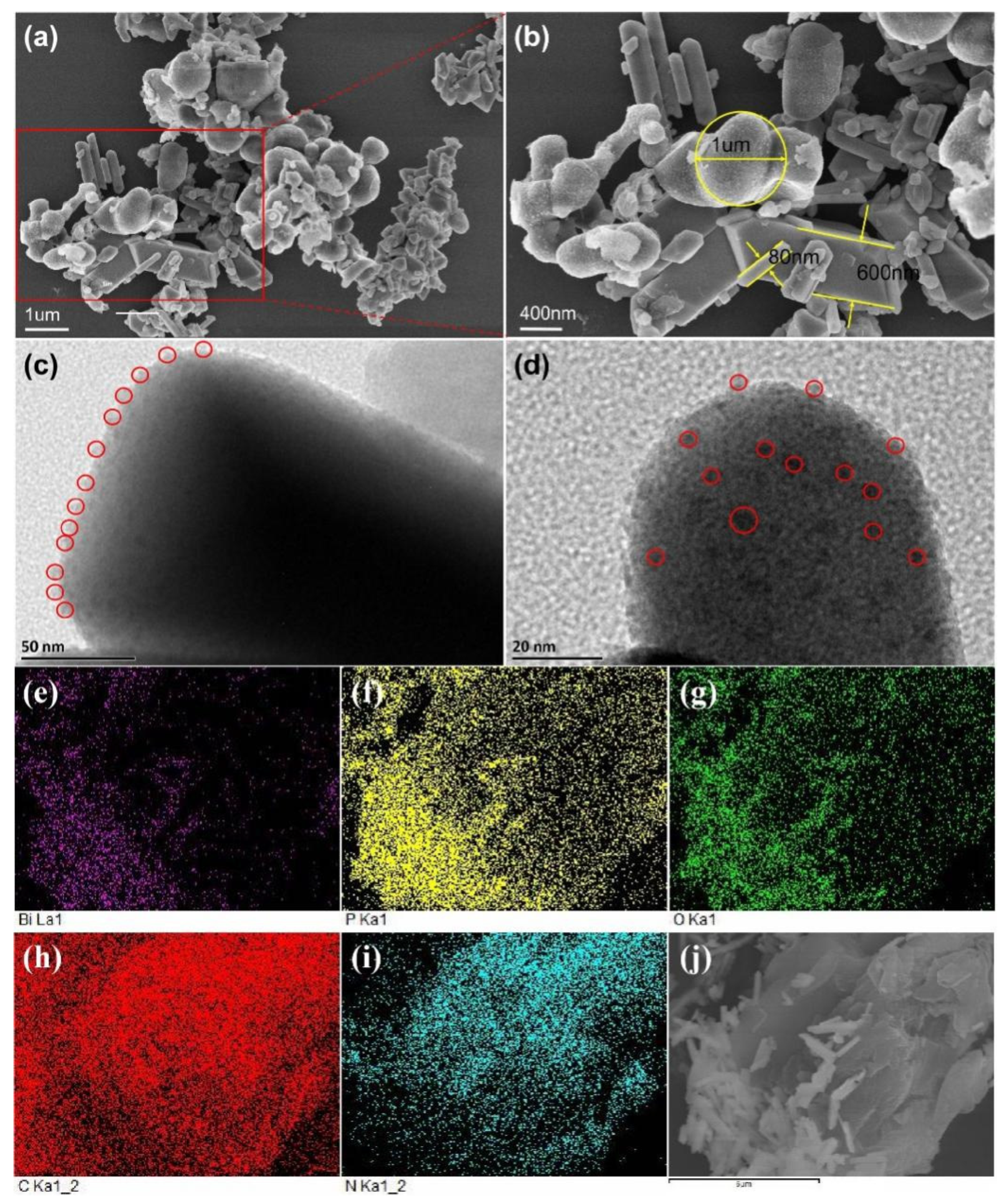

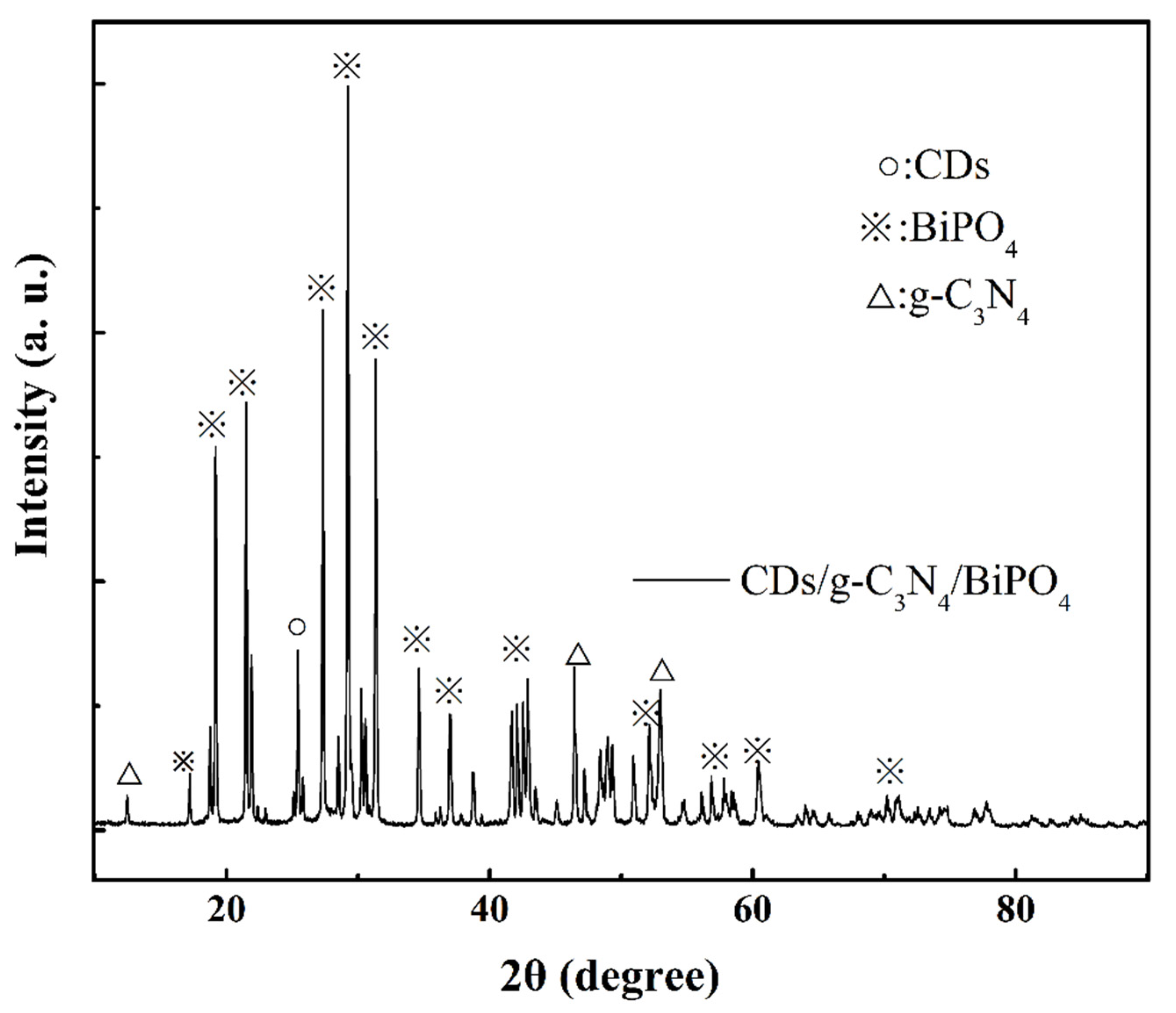
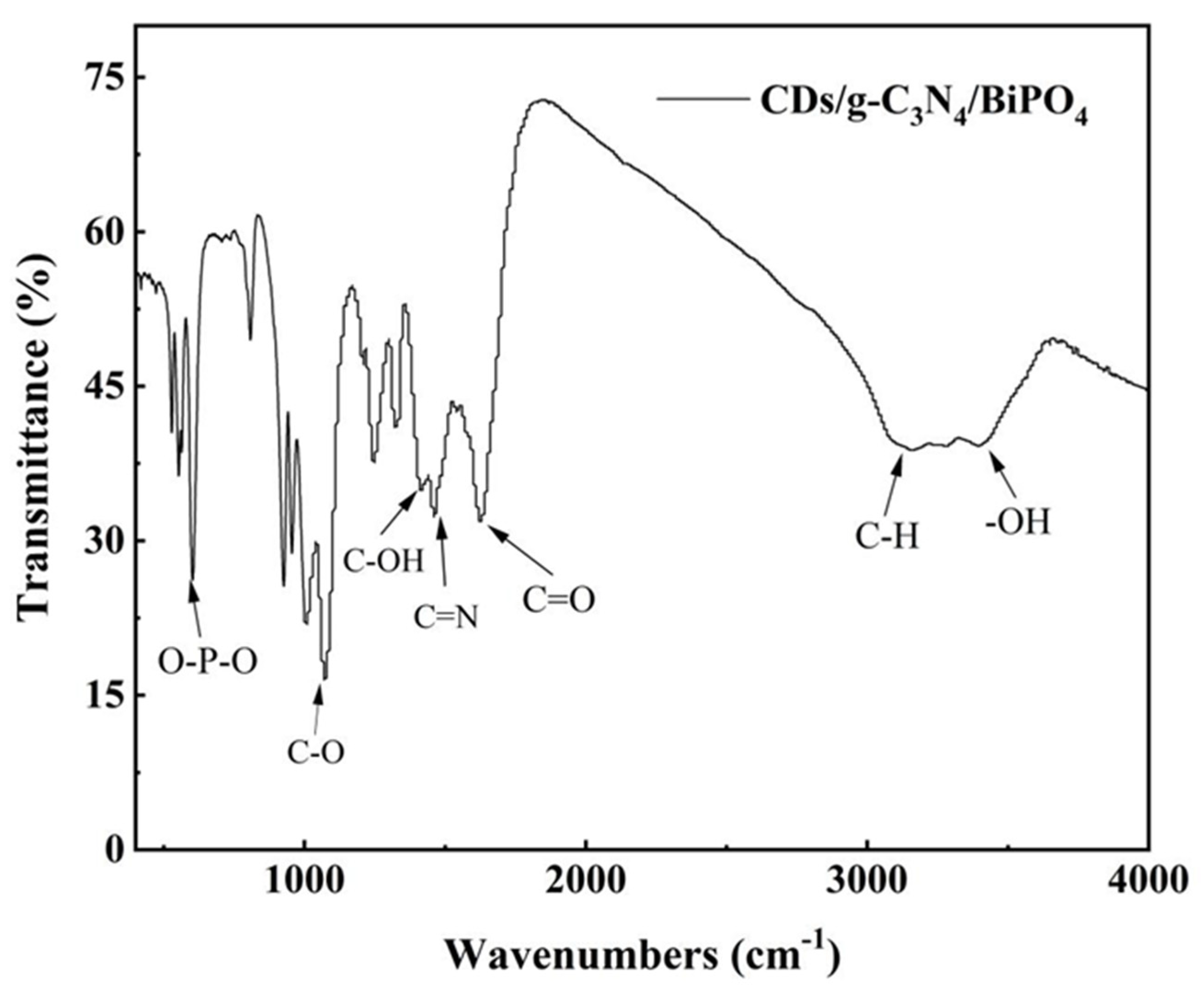
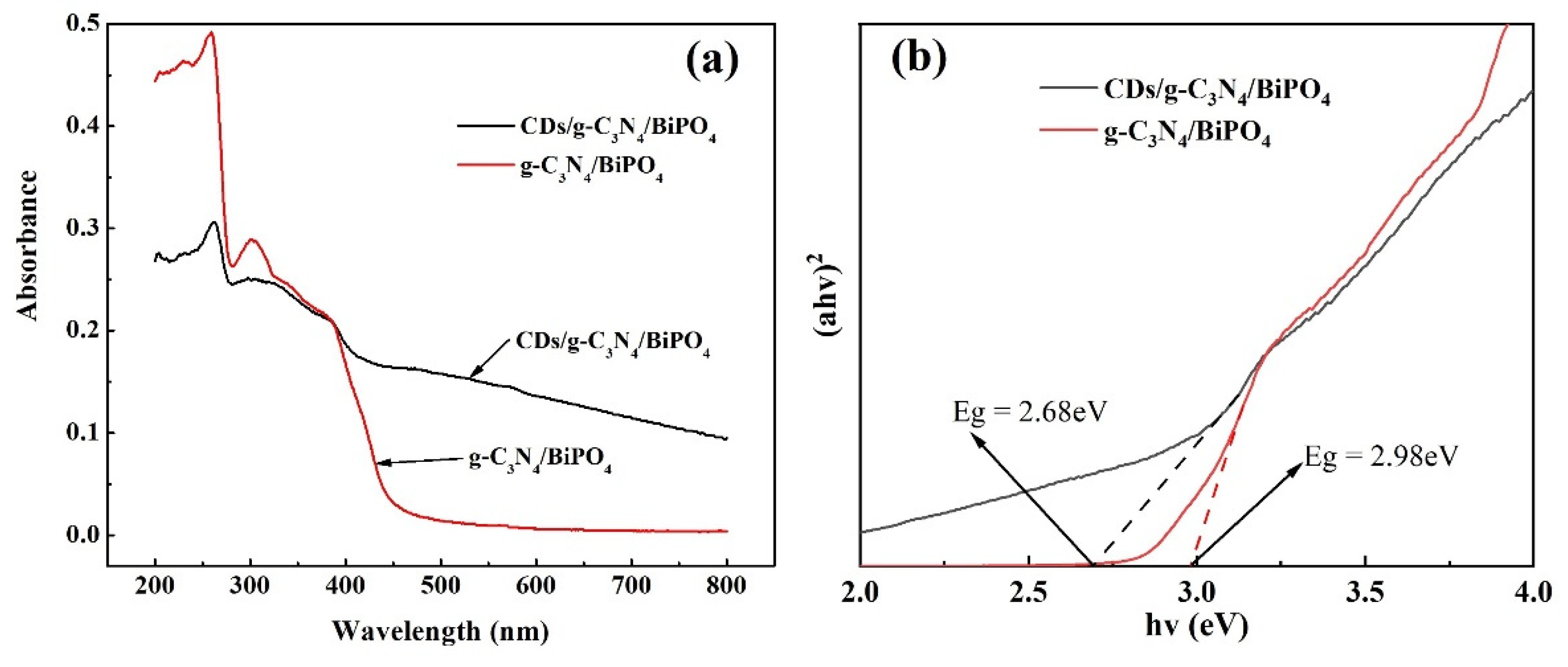

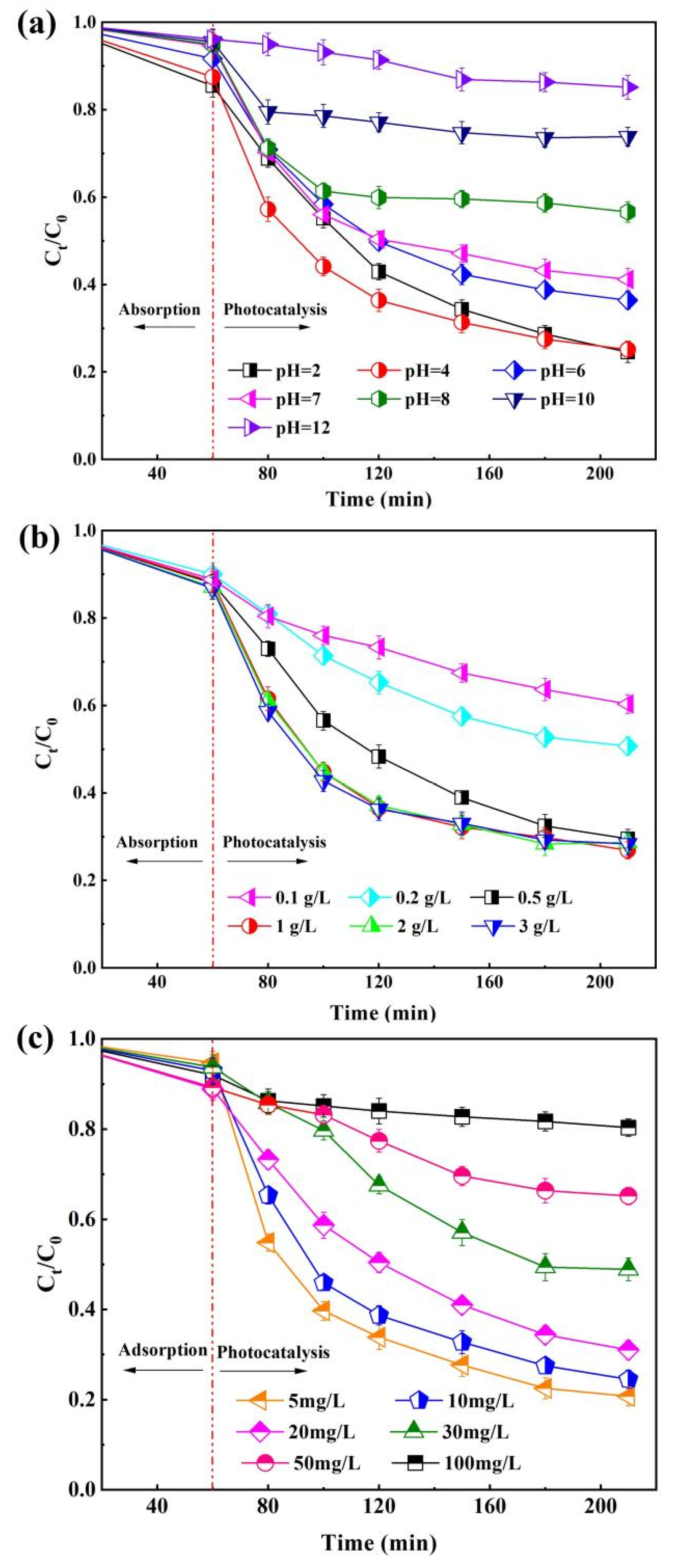
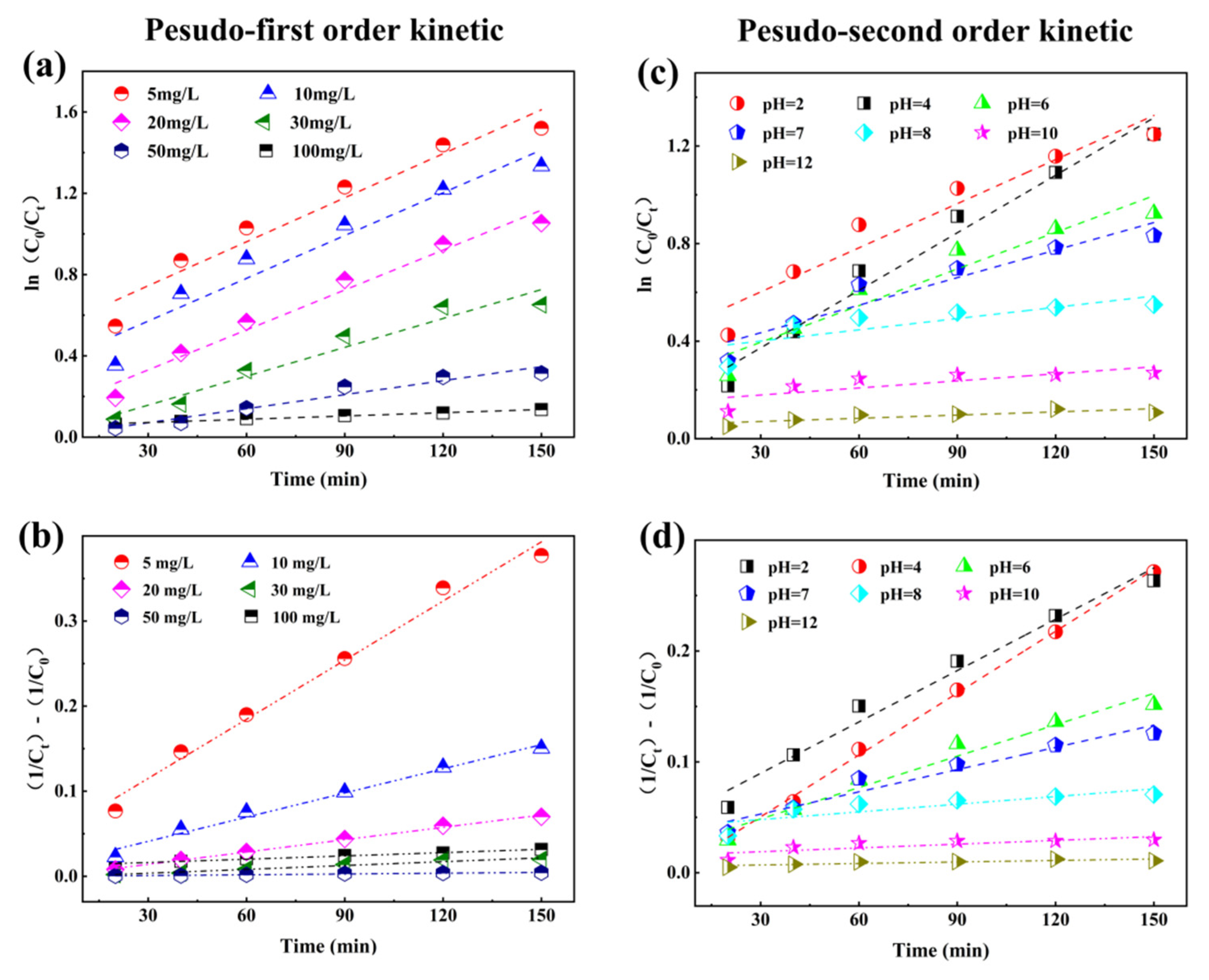
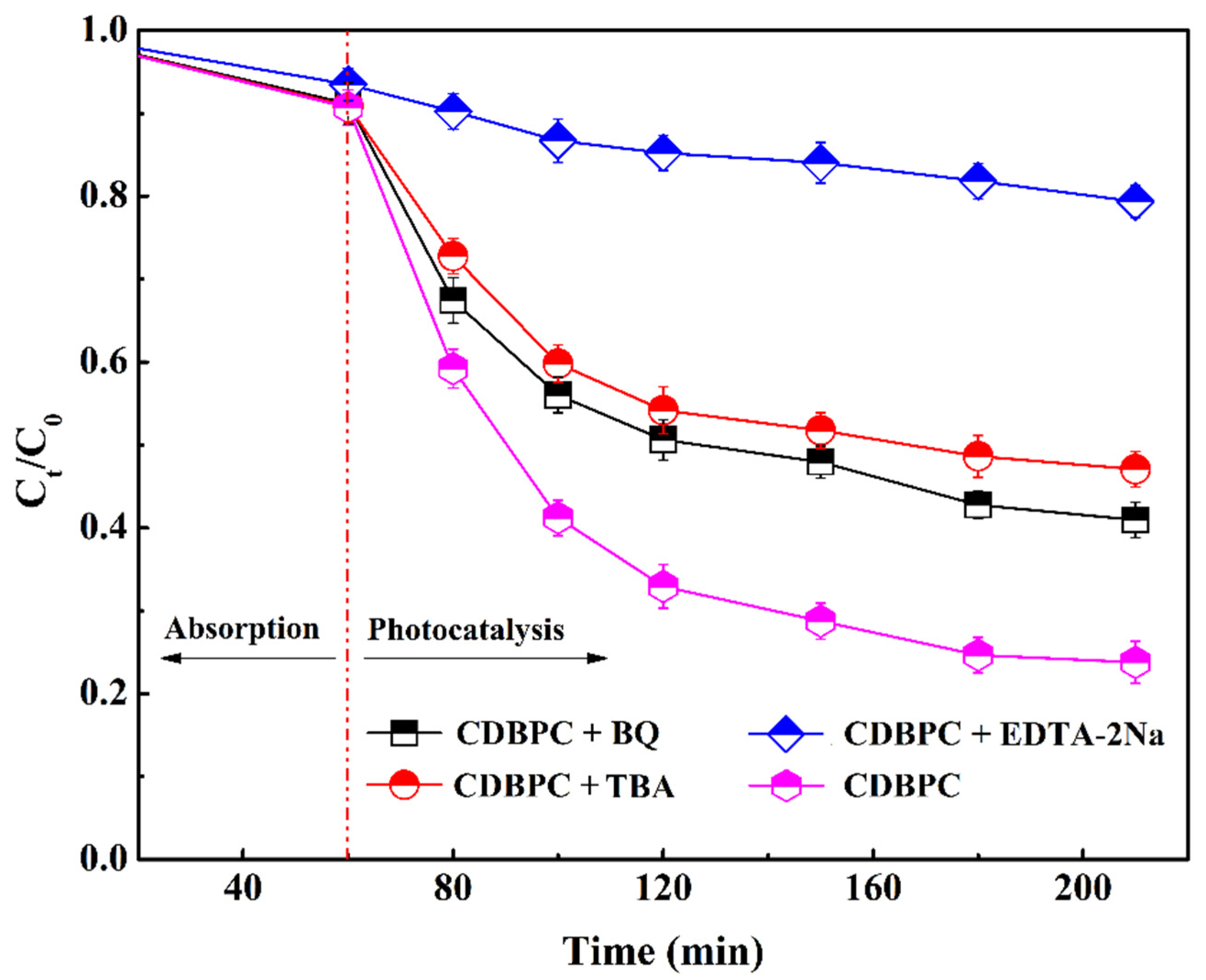
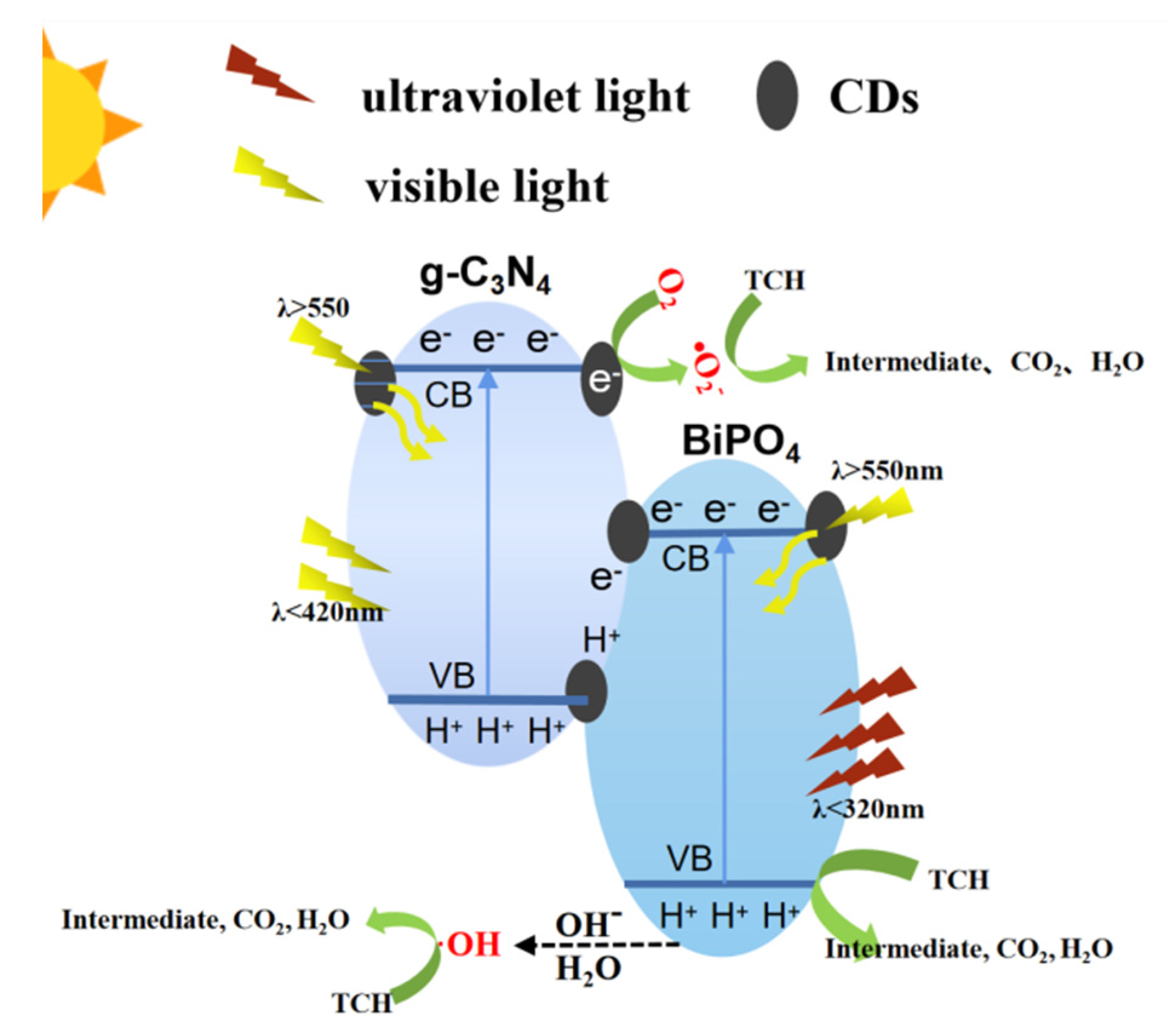

| Chemical Elements | C | N | Bi | P | O |
|---|---|---|---|---|---|
| mass ratio (wt %) | 34.84 | 37.98 | 15.91 | 1.61 | 9.66 |
| atomic fraction (%) | 43.26 | 40.45 | 0.69 | 0.78 | 14.83 |
| Initial Concentration (mg/L) | Pseudo-First-Order Kinetic Model | Pseudo-Second-Order Kinetic Model | ||||
|---|---|---|---|---|---|---|
| K (min−1) | R2 | t1/2 (min) | K (10−3 min−1) | R2 | t1/2 (min) | |
| 5 | 0.0072 | 0.9459 | 96.3 | 2.3 | 0.9876 | 87.0 |
| 10 | 0.007 | 0.9314 | 99.0 | 0.9 | 0.9858 | 111.1 |
| 20 | 0.0065 | 0.9731 | 106.6 | 0.5 | 0.9965 | 100.0 |
| 30 | 0.0047 | 0.9485 | 147.5 | 0.2 | 0.9606 | 166.7 |
| 50 | 0.0023 | 0.9481 | 301.4 | 0.1 | 0.955 | 200.0 |
| 100 | 0.0005 | 0.9937 | 1386.3 | 0.03 | 0.9949 | 333.3 |
| Initial Concentration (mg/L) | Pseudo-First-Order Kinetic Model | Pseudo-Second-Order Kinetic Model | ||||
|---|---|---|---|---|---|---|
| K (min−1) | R2 | t1/2 (min) | K (10−3 min−1) | R2 | t1/2 (min) | |
| 5 | 0.0072 | 0.9459 | 96.3 | 2.3 | 0.9876 | 87.0 |
| 10 | 0.007 | 0.9314 | 99.0 | 0.9 | 0.9858 | 111.1 |
| 20 | 0.0065 | 0.9731 | 106.6 | 0.5 | 0.9965 | 100.0 |
| 30 | 0.0047 | 0.9485 | 147.5 | 0.2 | 0.9606 | 166.7 |
| 50 | 0.0023 | 0.9481 | 301.4 | 0.1 | 0.955 | 200.0 |
| 100 | 0.0005 | 0.9937 | 1386.3 | 0.03 | 0.9949 | 333.3 |
Publisher’s Note: MDPI stays neutral with regard to jurisdictional claims in published maps and institutional affiliations. |
© 2022 by the authors. Licensee MDPI, Basel, Switzerland. This article is an open access article distributed under the terms and conditions of the Creative Commons Attribution (CC BY) license (https://creativecommons.org/licenses/by/4.0/).
Share and Cite
Qian, W.; Hu, W.; Jiang, Z.; Wu, Y.; Li, Z.; Diao, Z.; Li, M. Degradation of Tetracycline Hydrochloride by a Novel CDs/g-C3N4/BiPO4 under Visible-Light Irradiation: Reactivity and Mechanism. Catalysts 2022, 12, 774. https://doi.org/10.3390/catal12070774
Qian W, Hu W, Jiang Z, Wu Y, Li Z, Diao Z, Li M. Degradation of Tetracycline Hydrochloride by a Novel CDs/g-C3N4/BiPO4 under Visible-Light Irradiation: Reactivity and Mechanism. Catalysts. 2022; 12(7):774. https://doi.org/10.3390/catal12070774
Chicago/Turabian StyleQian, Wei, Wangtong Hu, Zhifei Jiang, Yongyi Wu, Zihuan Li, Zenghui Diao, and Mingyu Li. 2022. "Degradation of Tetracycline Hydrochloride by a Novel CDs/g-C3N4/BiPO4 under Visible-Light Irradiation: Reactivity and Mechanism" Catalysts 12, no. 7: 774. https://doi.org/10.3390/catal12070774
APA StyleQian, W., Hu, W., Jiang, Z., Wu, Y., Li, Z., Diao, Z., & Li, M. (2022). Degradation of Tetracycline Hydrochloride by a Novel CDs/g-C3N4/BiPO4 under Visible-Light Irradiation: Reactivity and Mechanism. Catalysts, 12(7), 774. https://doi.org/10.3390/catal12070774





